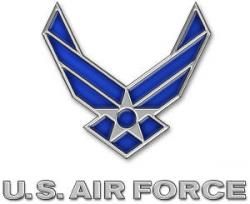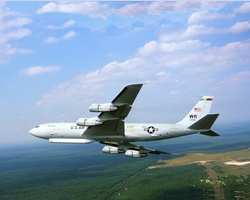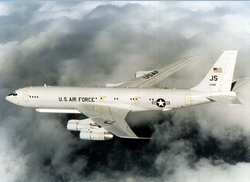Trauma Surgeon Gets First Hand Look At Military Procedures
 Air Force medical evacuation airmen had the benefit of flying
with a leading U.S. trauma surgeon during a recent mission to Iraq
as part of a program to link military and civilian medical
professionals.
Air Force medical evacuation airmen had the benefit of flying
with a leading U.S. trauma surgeon during a recent mission to Iraq
as part of a program to link military and civilian medical
professionals.
Thomas Scalea, physician in chief at the R. Adams Cowley Shock
Trauma Center in Baltimore, flew aboard a C-17 Globemaster III
transport jet on an Aug. 19 and 20 aeromedical evacuation mission
to help to shape future training for military medical teams
worldwide, Air Mobility Command officials said.
Scalea served as a lead contributor to the Air Force's Center
for Sustainment of Trauma and Readiness Skills, or C-STARS, a
medical service training program that links military medical
personnel with select civilian trauma care centers across the
country to prepare them for the types of cases they'll see while
caring for warfighters. "The goal of this trip was for Doctor
Scalea to observe the often difficult conditions Air Force teams
are faced with while aeromedically evacuating our troops from the
theater," said Air Force Col. (Dr.) Lawrence Riddles, U.S.
Transportation Command surgeon, who served as Scalea's escort.

C-STARS Aircraft File Photo
"He's already an advocate for our programs and is deeply
involved in our military health-care training, Riddles said. "Our
operations tempo is the highest I've seen in my career, and with
that, our training has to be the best. Giving our C-STARS partners
the chance to see these missions will make our training programs
more effective."
Results of the training speak for themselves. Since April 1,
2003, Air Force aeromedical evacuation personnel have flown more
than 136,000 patient movements worldwide, including more than 8,700
this year. During operations in Vietnam, it took an average of 45
days to return an injured troop to U.S. soil. Today, it takes an
average of three days. Additionally, wounded troops have a 95
percent chance of survival when they make it to into the hands of
the military's aeromedical evacuation experts, who are deployed all
over the world. Command officials attribute those successes to the
joint en route care system and to C-STARS, and similar training
programs.
"This trip was very eye-opening, and I was honored to be
included," Scalea said upon his return to the United States at
Andrews Air Force Base, MD. "In trauma centers, we are often
working in good conditions with the lighting we need and enough
space to move around," he said. "In the back of an airplane, the
[aeromedical evacuation] crews work with flashlights strapped to
their bodies and have to maneuver in and out of cramped spaces to
care for multiple trauma patients at a time. But that does not
impact the results. Each patient was cared for with the highest
standards, and the care was top-notch."
And that care isn't only reserved for U.S. troops. In late July,
Air Force aeromedical teams evacuated a British soldier out of
Afghanistan to life-saving care after being shot in the upper
abdomen and chest. The move took two airplanes to get the right
medical equipment and personnel in place, and a third plane to fly
the patient to further care. "Because of C-STARS, our medical
experts get hands-on experience with gunshot wounds, stab wounds,
internal injuries and much more, and they experience those
situations with world-renowned experts such as Doctor Scalea as an
instructor," Riddles said. "That prepares our teams for a lot of
what they'll see in the theater of operations, and it enables them
to make those often fast-paced, life-saving decisions."
Many aeromedical evacuation personnel have more than a couple
stories to back up the importance of programs like C-STARS.

C-STARS Aircraft File Photo
"After attending C-STARS, I was deployed to launch and recover
aeromedical evacuation missions as part of the aeromedical
evacuation operations team in Southwest Asia," said Air Force Maj.
Suzie Dietz, chief of aeromedical evacuation operations at the
618th Tanker Airlift Control Center here, and a flight nurse with
more than 15 years of experience. "I can definitely say that
C-STARS helped prepare us for the types of situations we faced in
the area of responsibility, and you can't put a price tag on the
life-saving results you see every day," Dietz said.
It takes an average of 6.6 hours for the most severely injured
patients to be flown out of Iraq and Afghanistan, according to
command records. The 618th is responsible for planning the missions
and staying in close contact with aircrews to accomplish the
worldwide aeromedical evacuation mission. All planning is closely
coordinated with U.S. Transportation Command through the Global
Patient Movement Requirements Center, which provides worldwide
oversight and synchronization of patient movement, integrating
medical regulating, evacuation service, and centralized command and
control.
"Doctor Scalea is in internationally recognized expert in the
field of trauma care and his expertise is an amazing resource for
the training of our [aeromedical evacuation] personnel," said Steve
Dugger, deputy chief of the 618th's aeromedical evacuation
branch.
C-STARS was created to help prepare Air Force medics to care for
critically injured military members and safely evacuate them for
follow-on care. The program is well worth the time and effort,
participants say.
"Seeing what these people do to care for others is amazing, and
the fact that they're doing it in the back of an airplane at 35,000
feet paints the picture of what the U.S. is willing to do to save
lives," Scalea said. "I'd be honored to work with these teams any
day of the week, and look forward to applying what I've experienced
to support the C-STARS program."
ANN Salutes Air Force Capt. Justin Brockhoff serves with the
618th Tanker Airlift Control Center public affairs office.
 Airborne 10.15.25: Phantom 3500 Confounds, Citation CJ3 Gen2 TC, True Blue Power
Airborne 10.15.25: Phantom 3500 Confounds, Citation CJ3 Gen2 TC, True Blue Power Airborne 10.14.25: Laser Threat, VeriJet BK, Duffy Threatens Problem Controllers
Airborne 10.14.25: Laser Threat, VeriJet BK, Duffy Threatens Problem Controllers Aero-News: Quote of the Day (10.20.25)
Aero-News: Quote of the Day (10.20.25) ANN's Daily Aero-Term (10.20.25): Flameout Pattern
ANN's Daily Aero-Term (10.20.25): Flameout Pattern NTSB Final Report: Schweizer SGS 2-33A
NTSB Final Report: Schweizer SGS 2-33A





